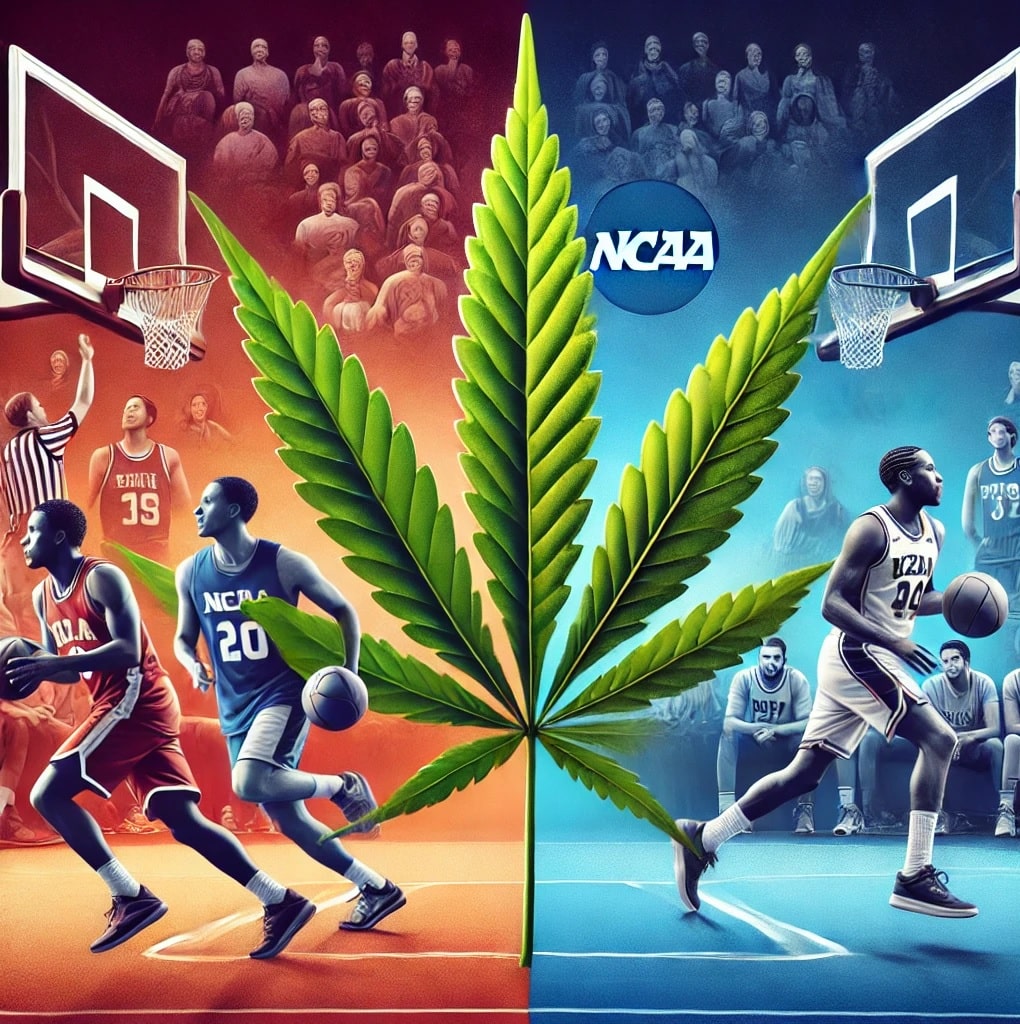
The NCAA’s Landmark Decision: Removing Cannabis from its List of Prohibited Substances for Division I Players
The National Collegiate Athletic Association (NCAA) has long been the governing body of college sports in the United States, overseeing the athletic programs of many colleges and universities. Over the years, the NCAA has implemented various policies aimed at maintaining the integrity of sports and ensuring the well-being of student-athletes. One such policy has been the prohibition of certain substances, including cannabis. However, a recent and historic decision by the NCAA to remove cannabis from its list of prohibited substances for Division I players, effective immediately, marks a significant shift in the landscape of collegiate athletics and substance regulation.
This blog delves into the details of this decision, exploring its implications for athletes, the rationale behind the change, and the broader societal context that has influenced this move.
A Historic Decision: The NCAA’s Cannabis Policy Change
The NCAA’s decision to remove cannabis from its list of prohibited substances for Division I athletes is monumental, not just for the organization but for the broader sports community. For decades, cannabis has been classified as a banned substance under NCAA regulations, with student-athletes facing suspensions and other penalties if they tested positive. This policy was in line with federal laws and societal views that classified cannabis alongside more harmful and addictive substances.
However, recent years have seen a significant shift in public opinion and legal frameworks regarding cannabis. The NCAA’s decision reflects this change, acknowledging that cannabis is no longer viewed in the same light as it was decades ago. This decision does not only impact the athletes directly but also sends a message about the evolving understanding of cannabis and its role in society.
The Rationale Behind the Decision
The decision to remove cannabis from the NCAA’s list of prohibited substances did not come overnight. It was the result of extensive research, debate, and reflection within the organization. Several key factors contributed to this historic change:
- Evolving Public Opinion and Legalization Trends:
- Over the past decade, there has been a significant shift in public opinion regarding cannabis marijuana and CBD. What was once seen as a dangerous drug is now legal for medicinal use in most states and for recreational use in an increasing number of states. This shift in public perception has been driven by a growing body of research highlighting the potential medicinal benefits of cannabis, as well as its relatively low risk compared to other substances like alcohol and tobacco.
- The NCAA recognized that continuing to ban a substance that is legal in many states where its member schools are located would be increasingly difficult to justify. This discrepancy between state laws and NCAA regulations created confusion and inconsistency in enforcement, leading to calls for reform.
- Medical Research and Understanding of Cannabis:
- Scientific research has shown that cannabis can have a range of therapeutic benefits, particularly in managing pain, anxiety, and other conditions that are common among athletes. Unlike opioids and other pain management drugs, cannabis has a lower risk of addiction and overdose.
- The NCAA’s decision reflects a growing recognition of the importance of evidence-based policy. By aligning their regulations with the latest scientific understanding, the NCAA is prioritizing the health and well-being of its athletes.
- Advocacy from Athletes and Stakeholders:
- Many athletes and advocates have long argued that the NCAA’s cannabis ban was outdated and overly punitive. They pointed out that cannabis is less harmful than other substances that were not banned by the NCAA, such as alcohol and prescription painkillers.
- Over the years, several high-profile athletes have been penalized for cannabis and CBD topical use, leading to widespread criticism of the policy. Advocacy from these athletes, along with support from medical professionals and other stakeholders, played a crucial role in pushing the NCAA to reconsider its stance.
Implications for Division I Athletes

The removal of cannabis from the NCAA’s list of prohibited substances has far-reaching implications for Division I athletes. This decision will affect various aspects of their lives, from their athletic careers to their personal health and well-being.
- Mental and Physical Health:
- One of the most significant benefits of this policy change is the potential positive impact on athletes’ mental and physical health. Many athletes use cannabis for pain management, recovery, and anxiety reduction. With the removal of the ban, athletes can now use cannabis without fear of penalty, allowing them to explore alternative methods of managing their health.
- This change is particularly important for athletes who suffer from chronic pain or injuries. Instead of relying on prescription painkillers, which can be addictive and have harmful side effects, athletes can now use cannabis as a safer alternative.
- Career and Reputation:
- The NCAA’s previous cannabis ban often led to harsh penalties for athletes who tested positive, including suspensions and damage to their reputations. These penalties could have long-lasting effects, potentially jeopardizing professional careers and future opportunities.
- With the removal of the ban, athletes no longer face the risk of career-altering penalties for cannabis use. This change allows athletes to focus on their performance and development without the added stress of potential sanctions.
- Leveling the Playing Field:
- The NCAA’s decision also helps level the playing field for athletes from states where cannabis is legal. Previously, athletes from these states faced a dilemma: adhere to state laws and use cannabis legally, or comply with NCAA rules and risk penalties. This inconsistency created an unfair advantage for athletes from states where cannabis was illegal.
- By removing the cannabis ban, the NCAA ensures that all athletes are subject to the same rules, regardless of their state of residence.
The Broader Societal Context
The NCAA’s decision to remove CBD and cannabis from its list of prohibited substances cannot be viewed in isolation. It is part of a broader societal shift in the perception and legalization of cannabis. Understanding this context is crucial to fully grasp the significance of this decision.
- Cannabis Legalization Across the U.S.:
- As of 2024, cannabis is legal for recreational use in 23 states and for medicinal use in 38 states. This widespread legalization has fundamentally changed how cannabis is viewed and used in society.
- The NCAA’s decision reflects the reality that cannabis is no longer a fringe issue but a mainstream topic with significant public support. By aligning its policies with state laws, the NCAA is recognizing the new legal and cultural landscape surrounding cannabis.
- Shift in Drug Policy and Criminal Justice Reform:
- The removal of cannabis from the NCAA’s prohibited substances list is also in line with broader trends in drug policy reform. Across the country, there is a growing movement to decriminalize or legalize cannabis and to address the disproportionate impact of drug laws on marginalized communities.
- The NCAA’s decision can be seen as part of this larger effort to rethink outdated drug policies and to adopt a more compassionate and evidence-based approach to substance regulation.
- Impact on Other Sports Organizations:
- The NCAA’s decision is likely to have ripple effects across the sports world. Other sports organizations, including professional leagues, may feel pressure to reevaluate their own cannabis policies in light of this change.
- This decision sets a precedent that could influence how cannabis is regulated in sports at all levels, from youth leagues to professional organizations.
The Path Forward: What’s Next for the NCAA and Collegiate Athletics?
The decision to remove cannabis from the NCAA’s list of prohibited substances is just the beginning of what is likely to be an ongoing conversation about substance use and athlete well-being. As the NCAA moves forward, several key areas will need to be addressed:
- Education and Awareness:
- With the removal of the cannabis ban, it will be crucial for the NCAA to provide education and resources to athletes about responsible cannabis use. This includes information on the potential risks and benefits of cannabis, as well as guidance on how to use it safely and legally.
- The NCAA can partner with medical professionals, mental health experts, and substance use specialists to develop comprehensive educational programs for athletes, coaches, and administrators.
- Monitoring and Evaluation:
- The NCAA will need to monitor the impact of this policy change on athletes and the broader sports community. This includes tracking health outcomes, performance, and any potential issues related to cannabis use.
- By regularly evaluating the effects of this decision, the NCAA can make informed adjustments to its policies and ensure that the well-being of athletes remains a top priority.
- Policy Alignment Across Divisions:
- Currently, the removal of cannabis from the prohibited substances list applies only to Division I athletes. The NCAA will need to consider whether this policy should be extended to Division II and III athletes as well.
- Aligning policies across divisions could help create a more consistent and fair regulatory framework for all NCAA athletes.
- Addressing Stigma:
- Despite the growing acceptance of cannabis, there is still stigma associated with its use, particularly in the sports community. The NCAA will need to work to reduce this stigma and create an environment where athletes feel comfortable discussing and using cannabis without fear of judgment or discrimination.
- This can be achieved through public statements, educational campaigns, and by fostering open dialogue within the collegiate sports community.
Conclusion: A New Era for Collegiate Athletics
The NCAA’s decision to remove cannabis from its list of prohibited substances marks the beginning of a new era in collegiate athletics. This historic move reflects the changing legal and cultural landscape surrounding cannabis and demonstrates the NCAA’s commitment to evolving with the times.
For Division I athletes, this decision offers new opportunities for managing their health and well-being while leveling the playing field and reducing the risk of career-altering penalties. For the broader sports community, the NCAA’s decision sets a precedent that could lead to further changes in how cannabis is regulated and perceived in sports.
As the NCAA and its member institutions move forward, the focus will be on ensuring that this policy change is implemented in a way that prioritizes the health and safety of athletes. By providing education, monitoring outcomes, and addressing stigma, the NCAA can help create a more supportive
